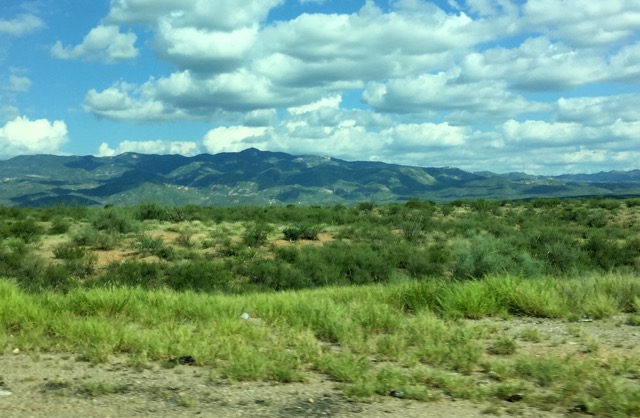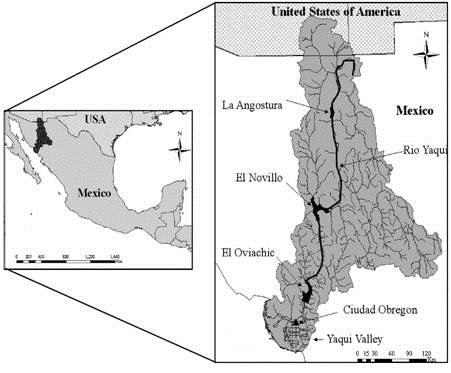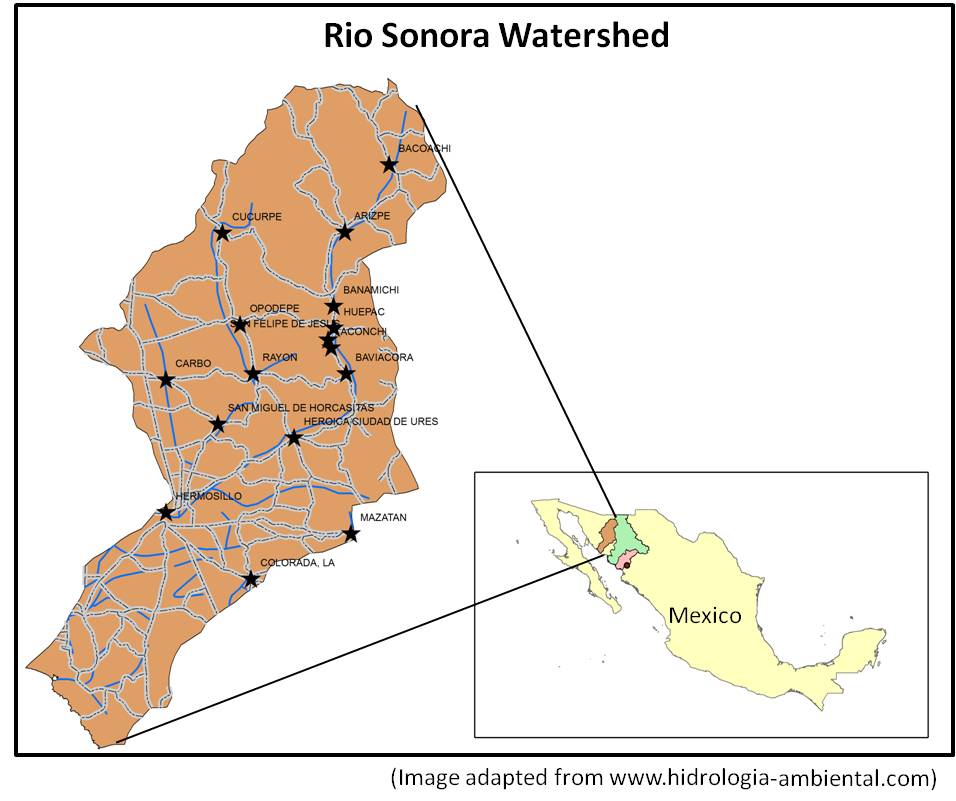 The Colegio de Sonora (Colson) hosted a workshop of water security projects on 20-21 August 2015 in Hermosillo, Sonora, Mexico. Partners from the University of Arizona (UA) visited Hermosillo to attend this important event, where graduate students funded by the International Water Security Network (IWSN) and by the Inter-American Institute for Global Change Research (IAI) presented their work progress.
The Colegio de Sonora (Colson) hosted a workshop of water security projects on 20-21 August 2015 in Hermosillo, Sonora, Mexico. Partners from the University of Arizona (UA) visited Hermosillo to attend this important event, where graduate students funded by the International Water Security Network (IWSN) and by the Inter-American Institute for Global Change Research (IAI) presented their work progress.
The partners from the UA who travelled to Hermosillo include Dr. Robert Varady (Deputy Director of the Udall Center for Studies in Public Policy and Principal Investigator of the IWSN Americas activity), Dr. Christopher Scott (Research Professor of Water Resources Policy at the Udall Center and Professor in the School of Geography & Development, and co-PI of the IWSN Americas activity), Dr. Adriana Zúñiga (Postdoctoral Research Associate at the Udall Center), UA Ph.D. candidate América Lutz-Ley, and UA Ph.D. student Yulia Peralta. Janaina Pasqual (Ph.D. student from Curitiba, Brazil, and currently a visiting scholar at the UA) also attended this event. A brief summary by water security topic follows.
Wastewater: Institutions and Management

showing greened desert landscape after the monsoon rains
Among the topics discussed during this workshop was the wastewater treatment plant in Hermosillo. Miguel Maya, a Ph.D. student at Colson, spoke on this subject. Miguel explained that there is a mandate from the federal government in Mexico to develop wastewater treatment plants in every municipality of the country. In response to this mandate, Hermosillo has attempted to build a treatment plant, but with unsuccessful results. Local residents have repeatedly protested against the location of a plant close to their homes. The almost-finished facility was left abandoned due to pressure from neighboring communities. A second wastewater treatment plant, now under construction close to Indian land, may face opposition in the future. This exemplifies a situation where stakeholder participation should have been considered since the beginning of the planning process.
River Basin Management

students for their outstanding presentations. To the right is
Dr. Adriana Zúñiga of the University of Arizona, and to the left
is Research Assistant Daniella Yocupicio of Colegio de Sonora
Several presentations addressed river basin management. One research project was a study of the institutional capacity of watershed councils; this project was presented by Erik Parra, who is a Ph.D. student at Colson. Dr. Alejandro Salazar, a Colson faculty researcher, summarised his project on drought mitigation in Hermosillo. And, Dr. Rolando Díaz, also a Colson faculty member, described his progress on a vulnerability study. Dr. Díaz is using remote sensing imagery and the Normalized Difference Vegetation Index (NDVI) as an indicator of vegetation to measure land-use and land-cover change in the Río Sonora basin. He wants to identify changes in vegetation and its related net primary productivity after agricultural fields were abandoned during the past drought. These projects on river basin management exemplify the coupling of social and ecological systems and how policies and users interact in the face of increasing scarcity of water resources. The outcomes of these interactions affect both social and ecological systems, resulting in vulnerable populations and desertification across the river basin.
Desalination
Dr. Nicolás Pineda, a senior researcher professor from Colson and the team leader of the Mexican activities, discussed his research proposal to study the desalination plant planned for Puerto Peñasco (also known as Rocky Point), in northern Sonora on the coast of the Sea of Cortés. This binational plant, should it be built, is expected to provide water to both Sonora and Arizona, across the international border. As part of his methodology, Dr. Pineda expects to use a Delphi survey to gather information about how policies are formed and implemented. The survey will be aimed at specific stakeholders from both countries. This study is highly significant because water policy across the U.S.- Mexico border is a very sensitive topic because of the contrasting modes of managing water in the two countries.
Climate Risk

Sonora, Mexico. The closest urban center is Ciudad Obregon
(Image: http://hidrologia-ambiental.com/proyectos)
Yulia Peralta of UA described her work on climate-related risk in the Yaqui Valley, one of the most productive agricultural regions in Mexico. She is working under the tutelage of Prof. Margaret Wilder of the UA School of Geography and Development and the Udall Center. Yulia spent the 2015 summer in Ciudad Obregón, Sonora, interviewing farmers and government officials who work in the Yaqui Valley. She is examining the impacts of climate change in this region and farmers adaptive strategies. Among her preliminary results is that increasing temperatures causing the lack of ‘cold hours’ is the greatest challenge currently facing Río Yaqui producers, resulting in less productivity and the emergence of new combinations of fungi that affect their crops. Also, drought and policy changes have driven unsustainable demand for groundwater. Among the producers’ group, adaptive strategies vary greatly. Private farmers have opened new wells and new crop regimes (supported by the government). Moreover, small sustainable practices are starting to arise in this region, such as an association of organic agriculture, women’s conservation groups, and permaculture design.
Climate Change Adaptation
 Finally, América Lutz-Ley shared some early results of her research on rural climate change adaptation in the Rio Sonora basin. She is specifically working in three rural communities within the watershed that include Cucurpe, Rayón, and San Miguel de Horcasitas. América is conducting stakeholder interviews and she has found that most of the people living in these rural communities are not aware of climate change per se, but they are noticing changes in weather conditions, such as hotter temperatures and altered rainfall patterns. Conditions that used to be traditional signs of rain events for rural habitants now are obsolete, and can no longer be used as inputs for households’ decision making regarding agricultural and livestock production. As expected, the most vulnerable people are the poorest, and the lack of adequate infrastructure for water management is reducing rural resilience. She has observed that the communities lack strong social cohesion, which also increases their vulnerability to climate change. América is continuing fieldwork during this autumn to complete her project in 2016.
Finally, América Lutz-Ley shared some early results of her research on rural climate change adaptation in the Rio Sonora basin. She is specifically working in three rural communities within the watershed that include Cucurpe, Rayón, and San Miguel de Horcasitas. América is conducting stakeholder interviews and she has found that most of the people living in these rural communities are not aware of climate change per se, but they are noticing changes in weather conditions, such as hotter temperatures and altered rainfall patterns. Conditions that used to be traditional signs of rain events for rural habitants now are obsolete, and can no longer be used as inputs for households’ decision making regarding agricultural and livestock production. As expected, the most vulnerable people are the poorest, and the lack of adequate infrastructure for water management is reducing rural resilience. She has observed that the communities lack strong social cohesion, which also increases their vulnerability to climate change. América is continuing fieldwork during this autumn to complete her project in 2016.
The collection of targeted research projects exemplifies how water security in arid lands – in this case in Northern Mexico – can be studied from different perspectives and at different scales: from local communities, to urban settings, to the international transboundary level. The funds provided by Lloyd’s Register Foundation through the IWSN are being used to train several graduate students in water security-related research projects.

